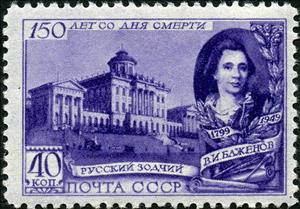Stamp: Vasily I. Bazhenov (1737/38-1799), Russian architect (Soviet Union, USSR 1949)
Vasily I. Bazhenov (1737/38-1799), Russian architect (Soviet Union, USSR 1949)
01 January (Soviet Union, USSR ) within release 10th Anniversary of Reunion of W.Ukraine and W.Belarus goes into circulation Stamp Vasily I. Bazhenov (1737/38-1799), Russian architect face value 40 Russian kopek
| Stamp Vasily I. Bazhenov (1737/38-1799), Russian architect in catalogues | |
|---|---|
| Michel: | Mi:SU 1367 |
Stamp is square format.
Also in the issue 10th Anniversary of Reunion of W.Ukraine and W.Belarus:
- Stamp - Coat of Arms of Byelorussian SSR face value 40;
- Stamp - Lenin's Mausoleum face value 40;
- Stamp - Vasily Williams (1863-1939), Russian and Soviet agronomist face value 25;
- Stamp - Soviet woman in Textile industry face value 20;
- Stamp - Soviet woman in Pre-school Education face value 25;
- Stamp - Soviet woman in the management of state affairs face value 40;
- Stamp - Women in Socialistic Agriculture face value 50;
- Stamp - Soviet schoolmistress face value 50;
- Stamp - Soviet woman in mass sport face value 1;
- Stamp - Stepan O. Makarov (1849-1904), Russian naval commander face value 40;
- Stamp - The Building Of Military medic academy face value 40;
- Stamp - S. Botkin, N. Pirogov, I. Sechenov & Military medic academy face value 50;
- Stamp - Miner with coal hammer face value 15;
- Stamp - Scientist at microscope face value 30;
- Stamp - Coat of Arms of the USSR face value 40;
- Stamp - Working people with May Day banner face value 40;
- Stamp - Soviet newspapers and works by Marx, Lenin, Stalin face value 40;
- Stamp - Alexander Popov, inventor of radio face value 40;
- Stamp - A.Popov shows the world's first radioset to admiral Makarov face value 50;
- Stamp - Alexander S. Pushkin (1799-1837), Russian author face value 25;
- Stamp - A.S. Pushkin among his friends in Kamenka face value 40;
- Stamp - Boldino State Literary Memorial and Museum of A. Pushkin face value 1;
- Stamp - Ivan Michurin (1855-1935), Russian botanist and selectionist face value 40;
- Stamp - Tugboat face value 40;
- Stamp - Vasily V. Dokuchayev (1846-1903), Russian geologist face value 40;
- Stamp - Vasily I. Bazhenov (1737/38-1799), Russian architect face value 40;
- Stamp - Alexander N. Radishchev (1749-1802), Russian author face value 40;
- Stamp - Khosta: Sanatorium of the Ministry of Communications face value 40;
- Stamp - Khosta: Sanatorium #3 of Trade unions of USSR face value 40;
- Stamp - Khosta: Sanatorium of power engineering specialists face value 40;
- Stamp - Zheleznovodsk: Sanatorium #41 of Trade unions of USSR face value 40;
- Stamp - Sochi: State Theatre face value 40;
- Stamp - Sochi: Frunze Sanatorium face value 40;
- Stamp - Makhinjauri: Sanatorium "Zelyony mys" of Trade Unions face value 40;
- Stamp - Kislovodsk: Sanatorium #1 of Trade unions of USSR face value 40;
- Stamp - Kislovodsk: Sanatorium #3 of Trade unions of USSR face value 40;
- Stamp - Ivan P. Pavlov (1849-1936), Russian physiologist face value 40;
- Stamp - The Globe belted with envelopes face value 40;
- Stamp - The Globe belted with envelopes face value 40;
- Stamp - Field-protective forestation face value 25;
- Stamp - Forest shelterbelts to collective farm fields face value 40;
- Stamp - Map of forest shelterbelts and field-protective forest face value 40;
- Stamp - Build ponds and reservoirs! face value 50;
- Stamp - Field-protective forestation face value 1;
- Stamp - Vasily I. Chapayev (1887-1919), Hero of Civil War face value 40;
- Stamp - Ivan S. Nikitin (1824-1861), Russian poet face value 40;
- Stamp - The building of Maly Theatre and Order of Lenin face value 40;
- Stamp - Maly Theater face value 50;
- Stamp - People's parade on Red square face value 40;
- Stamp - Cattle (Bos primigenius taurus), Sheep (Ovis ammon aries), M face value 40;
- Stamp - Gymnastics. Female gymnast on rings. face value 40;
- Stamp - Weightlifting face value 1;
- Stamp - Four-axle full-metal tramcar (MTV-82) face value 25;
- Stamp - Freight steam locomotive (class "L", config. 1-5-0) face value 50;
- Stamp - Coat of Arms and State Flag of the USSR face value 40;
- Stamp - Textile industrial complex. Cotton and trucks. face value 20;
- Stamp - Irrigation System face value 25;
- Stamp - The House of the Government of Tajik SSR in Stalinabad face value 40;
- Stamp - Medical college and Teacher's training college in Stalinabad face value 50;
- Stamp - Reunion of Western Byelorussia with Byelorussian SSR face value 40;
- Stamp - Worker with flag behind globe face value 40;
Stamp Vasily I. Bazhenov (1737/38-1799), Russian architect it reflects the thematic directions:
Famous People refers to the fame and public attention accorded by the mass media to individuals or groups or, occasionally, animals, but is usually applied to the persons or groups of people (celebrity couples, families, etc.) themselves who receive such a status of fame and attention. Celebrity status is often associated with wealth (commonly referred to as fame and fortune), while fame often provides opportunities to make money.
Architecture (Latin architectura, from the Greek ἀρχιτέκτων arkhitekton "architect", from ἀρχι- "chief" and τέκτων "builder") is both the process and the product of planning, designing, and constructing buildings and other physical structures. Architectural works, in the material form of buildings, are often perceived as cultural symbols and as works of art. Historical civilizations are often identified with their surviving architectural achievements.
An architect is a person who plans, designs, and oversees the construction of buildings. To practice architecture means to provide services in connection with the design of buildings and the space within the site surrounding the buildings that have human occupancy or use as their principal purpose. Etymologically, the term architect derives from the Latin architectus, which derives from the Greek (arkhi-, chief + tekton, builder), i.e., chief builder
A building or edifice is a structure with a roof and walls standing more or less permanently in one place, such as a house or factory. Buildings come in a variety of sizes, shapes and functions, and have been adapted throughout history for a wide number of factors, from building materials available, to weather conditions, to land prices, ground conditions, specific uses and aesthetic reasons. Buildings serve several needs of society – primarily as shelter from weather, security, living space, privacy, to store belongings, and to comfortably live and work. A building as a shelter represents a physical division of the human habitat (a place of comfort and safety) and the outside (a place that at times may be harsh and harmful).
A symbol is a mark, sign, or word that indicates, signifies, or is understood as representing an idea, object, or relationship. Symbols allow people to go beyond what is known or seen by creating linkages between otherwise very different concepts and experiences. All communication (and data processing) is achieved through the use of symbols. Symbols take the form of words, sounds, gestures, ideas, or visual images and are used to convey other ideas and beliefs. For example, a red octagon is a common symbol for "STOP"; on maps, blue lines often represent rivers; and a red rose often symbolizes love and compassion. Numerals are symbols for numbers; letters of an alphabet may be symbols for certain phonemes; and personal names are symbols representing individuals.





